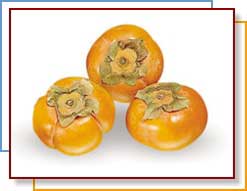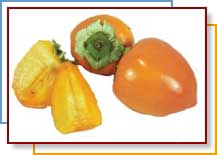Home | FOOD ARTICLES | Food Trivia | Today_in_Food_History | Food_History_Timeline | Recipes | Cooking_Tips | Food_Videos | Food_Quotes | Who’s_Who | Culinary_Schools_&_Tours | Food_Trivia_Quizzes | Food_Poems | Free_Magazines | Food_Festivals_and_Events
Food Articles, News & Features Section
FREE Magazines
and other Publications
Free Professional and Technical Research, White Papers, Case Studies, Magazines, and eBooks
PERSIMMONS
Persimmons origins go back to ancient China. Fate intervened in the 1880’s when a United States Commander brought back a native Japanese persimmon variety to Washington, D.C. Now, persimmons are grown in California where hundreds of different varieties flourish. This brightly colored, glossy orange red skinned fruit is an excellent source of vitamin A, a good source of vitamin C, and rich in fiber.
Although there are countless different varieties of persimmons, only two are commercially available. There are distinguishable by their shape.
Hachiya:
This type of persimmon makes up approximately 90 percent of the available fruit. It is identifiable by its acorn like shape. This persimmon is tart until it becomes soft ripe.
Fuyu:
This persimmon is gaining popularity here as it is in Japan. Similar in color, but looking like a squashed tomato, this variety is smaller, sweeter, and is edible while still firm.
AVAILABILITY, SELECTION, STORAGE, PREPARATION
Persimmons are widely available September through December, with a peak during November.
Choose persimmons with deep red undertones. Look for persimmons that are round, plump, and have glossy and smooth skin. Avoid fruits with blemishes, bruises or cracked skin and missing the green leaves at the top. Select ripe persimmons only if you plan to eat them immediately. Otherwise, buy firmer fruits and allow them to ripen.
Ripen persimmons at room temperature in a paper bag with an apple or banana. Store them in the refrigerator when ripe. Be sure to eat the fruit as soon as possible because overripe persimmons quickly turn to a mushy texture.
Ripe Fuyu persimmons, which look kind of like flattened tomatoes, will be crisp, while the acorn-shaped Hachiyas will be very soft and juicy.
Unripe Hachiya persimmons taste very bitter and will suck all the moisture from your mouth — not very pleasant. The tartness will go away as the fruit ripens.
MAKE PERSIMMONS PART OF YOUR 5 A DAY PLAN 
* Wash Fuyu persimmons, remove core and leaves, and slice or eat whole.
* Rinse Hachiya persimmons and slice in half. Remove seeds and spoon fruit out of skin.
* Add firm Fuyu persimmon slices to salads.
* Puree Hachiya persimmon flesh and add it to drinks, smoothies, or fresh fruit sauces. You can also use the puree to make cookies.
* Slice Fuyu and spread with lime juice, salt, and chili powder. Eat with a slice of low fat cheese.
* Mix cubed Fuyu with grapes, pomegranate seeds, cubed apple, and sliced kiwi for a colorful fall salad.
* Top hot or cold cereal with cubed pieces of bright orange Fuyu.
* Make salsa with a twist ? add chopped Fuyu, onion, tomatillo, cilantro, and chili Serrano and mix together.
* Start your morning off right! Add chopped or blended Fuyu persimmons to your pancakes, waffles, and French toast.
* Have an instant persimmon sherbet! Simply cut off a piece of the pointed tip of the fruit, tightly wrap the fruit, and freeze for up to three months. Defrost the fruit in the refrigerator for about four hours, scoop the fruit, and enjoy!
RELATED ARTICLES
Please feel free to link to any pages of FoodReference.com from your website.
For permission to use any of this content please E-mail: james@foodreference.com
All contents are copyright © 1990 - 2025 James T. Ehler and www.FoodReference.com unless otherwise noted. All rights reserved.
You may copy and use portions of this website for non-commercial, personal use only.
Any other use of these materials without prior written authorization is not very nice and violates the copyright.
Please take the time to request permission.

